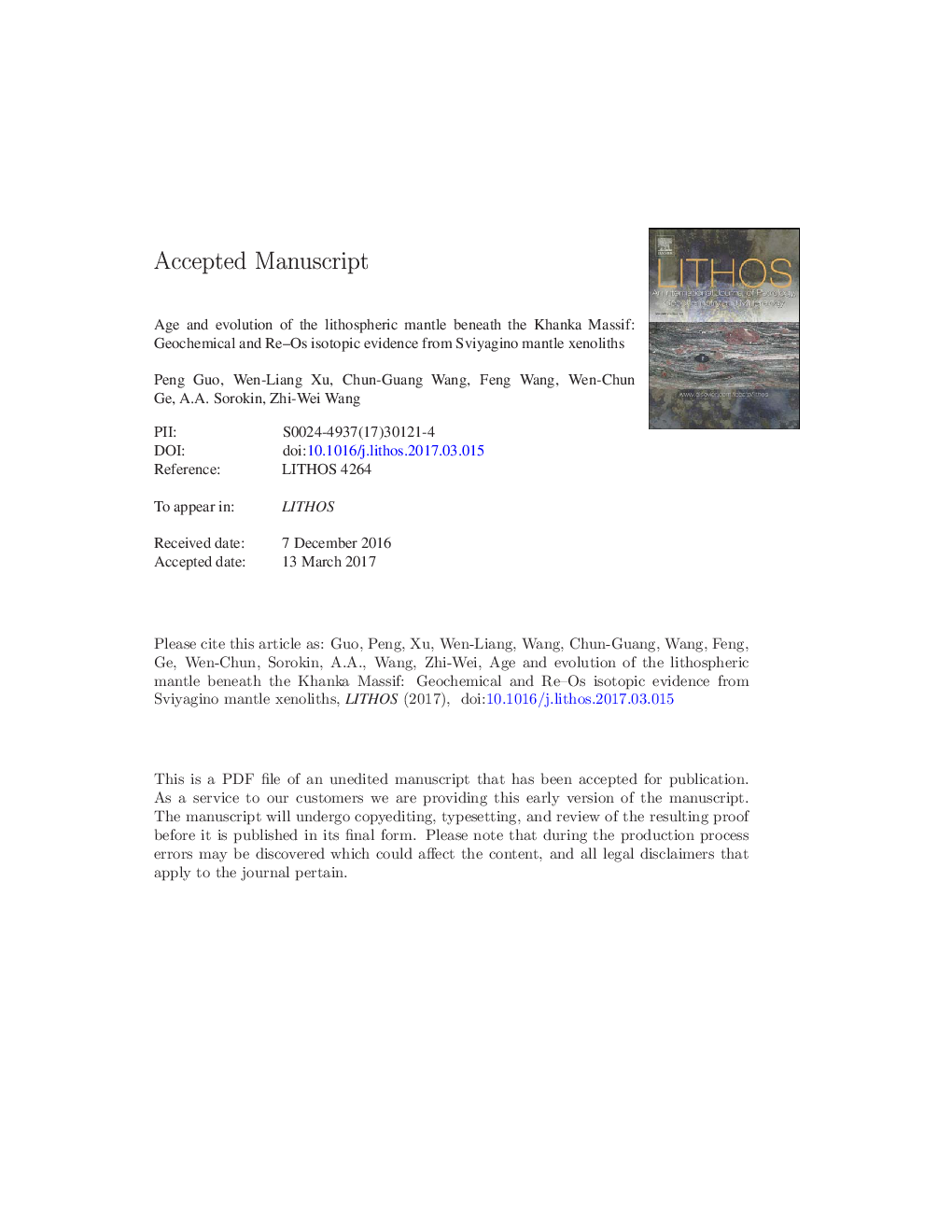| کد مقاله | کد نشریه | سال انتشار | مقاله انگلیسی | نسخه تمام متن |
|---|---|---|---|---|
| 5784137 | 1638631 | 2017 | 53 صفحه PDF | دانلود رایگان |
عنوان انگلیسی مقاله ISI
Age and evolution of the lithospheric mantle beneath the Khanka Massif: Geochemical and Re-Os isotopic evidence from Sviyagino mantle xenoliths
دانلود مقاله + سفارش ترجمه
دانلود مقاله ISI انگلیسی
رایگان برای ایرانیان
کلمات کلیدی
موضوعات مرتبط
مهندسی و علوم پایه
علوم زمین و سیارات
ژئوشیمی و پترولوژی
پیش نمایش صفحه اول مقاله

چکیده انگلیسی
New geochemical and Re-Os isotopic data of mantle xenoliths entrained in Cenozoic Sviyagino alkali basalts from the Russian Far East provide insights into the age and evolution of the sub-continental lithospheric mantle (SCLM) beneath the Khanka Massif, within the Central Asian Orogenic Belt (CAOB). These mantle xenoliths are predominantly spinel lherzolites with minor spinel harzburgite. The lherzolites contain high whole-rock concentrations of Al2O3 and CaO, with low forsterite content in olivine (Fo = 89.5-90.3%) and low Cr# in spinel (0.09-0.11). By contrast, the harzburgite is more refractory, containing lower whole rock Al2O3 and CaO contents, with higher Fo (91.3%) and spinel Cr# (0.28). Their whole rock and mineral compositions suggest that the lherzolites experienced low-degree (1-4%) batch melting and negligible metasomatism, whereas the harzburgite underwent a higher degree (10%) of fractional melting, and experienced minor post-melting silicate metasomatism. Two-pyroxene rare earth element (REE)-based thermometry (TREE) yields predominant equilibrium temperatures of 884-1043 °C, similar to values obtained from two-pyroxene major element-based thermometry (TBKN = 942-1054 °C). Two lherzolite samples yield high TREE relative to TBKN (TREE â TBKN â¥Â 71 °C), suggesting that they cooled rapidly as a result of the upwelling of hot asthenospheric mantle material that underplated a cold ancient lithosphere. The harzburgite with a low Re/Os value has an 187Os/188Os ratio of 0.11458, yielding an Os model age (TMA) relative to the primitive upper mantle (PUM) of 2.09 Ga, and a Re depletion ages (TRD) of 1.91 Ga; both of which record ancient melt depletion during the Paleoproterozoic (~ 2.0 Ga). The 187Os/188Os values of lherzolites (0.12411-0.12924) correlate well with bulk Al2O3 concentrations and record the physical mixing of ancient mantle domains and PUM-like ambient mantle material within the asthenosphere. This indicates that the SCLM beneath the Khanka Massif had been formed since at least the Paleoproterozoic (~ 2.0 Ga), and was replaced by juvenile (Phanerozoic) mantle material accreted from the asthenosphere. The synthesis of available TRD ages for mantle-derived rocks and sulfides in xenoliths is consistent with the prior existence of a common Paleoproterozoic (~ 2.0 Ga) SCLM beneath the eastern CAOB. Finally, comparing of mantle TRD ages and the ages of crustal rocks suggests temporal and genetic links between crust and mantle formation during the evolution of the CAOB.
ناشر
Database: Elsevier - ScienceDirect (ساینس دایرکت)
Journal: Lithos - Volumes 282â283, June 2017, Pages 326-338
Journal: Lithos - Volumes 282â283, June 2017, Pages 326-338
نویسندگان
Peng Guo, Wen-Liang Xu, Chun-Guang Wang, Feng Wang, Wen-Chun Ge, A.A. Sorokin, Zhi-Wei Wang,